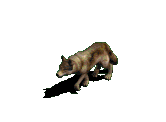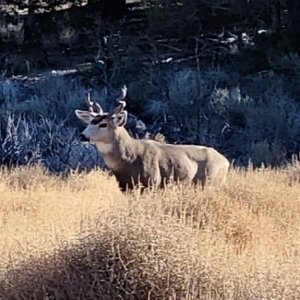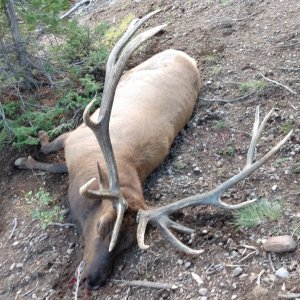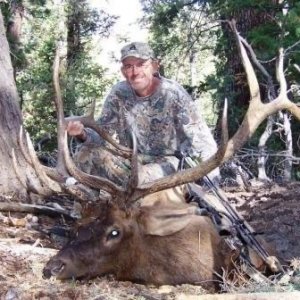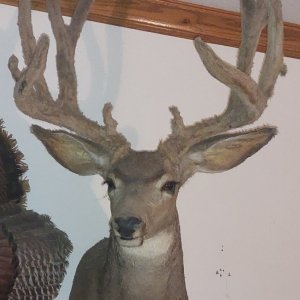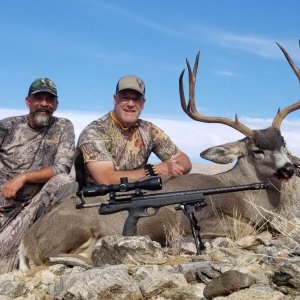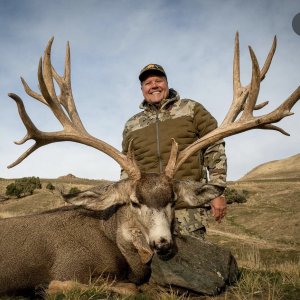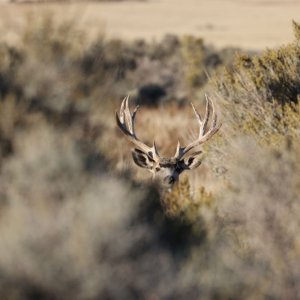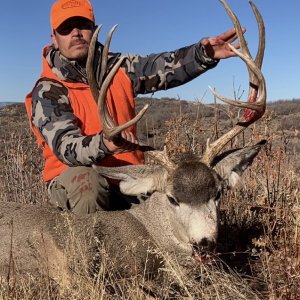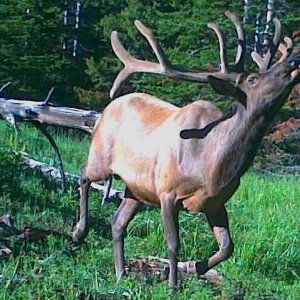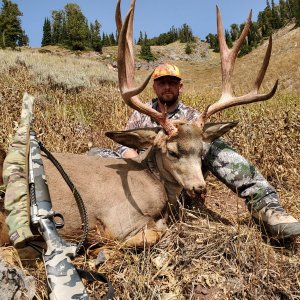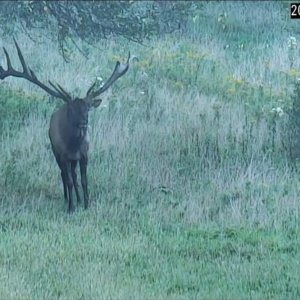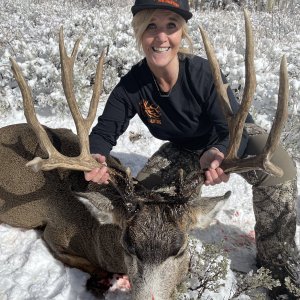7
7D
Guest
by Sam Curtis
When it comes to herd dynamics, female and male mule deer are on totally different planet
This story is featured in
Montana Outdoors
November/December 2005
"Girls kick ass? proclaimed the bumper sticker that was proudly displayed on a female college student's car. The young woman who got out of the driver?s seat embodied the notion behind the sticker that women are confident, powerful, and tough. Montana FWP research biologists have discovered the same is often true in mule deer society. In fact, that bumper sticker could be the unofficial motto for mule deer research conducted over the past decade by Ken Hamlin and ##### Mackie, who studied mule deer population dynamics in the Missouri Breaks, and by Dave Pac and Henry Jorgensen, who (along with Mackie) studied muley population dynamics in the Bridger Mountains. Their studies show that mule deer live in a matriarchal society where females are the prime movers and shakers. Mature does grab the best habitats and kick out their sons at an early age. Meanwhile, these powerful matriarchs show the daughters, who inherit the family land, the secrets of survival and how to carry on the family line. It's something of a wildlife soap opera.
Strong Mothers
In any given mule deer population, the oldest females (called matriarchs) take over core blocks of prime habitat they willingly share with their daughters for most of the year. Within this home range, the matriarch establishes her own private birthing territory. Just before she gives birth, in late May or early June, the matriarch temporarily drives off her yearling daughter and any other cling-on daughters from previous years, so she can deliver and rear her newborn fawn in solitude.
The matriarch continues to give the brush-off to her yearling daughter for most of the summer. The young doe survives, however, because her mother had schooled her during the previous summer on how to find nutritious food, hiding cover, and shelter from harsh weather. The yearling daughter usually decides it's convenient to establish a home range that generally overlaps that of her mother?s. It's kind of like living across the street from Mom.
If for some reason the yearling daughter tries to set up housekeeping in a totally different area, she usually wanders into the birthing territory of other matriarchs in the population and subsequently is shooed off by them. That forces her to return to familiar turf and her mother?s apron strings.
It's not because she's mean that a mature doe chases away her subadult offspring during and immediately following the birth of her fawn. It's how she reduces the risk of attracting the attention of bears, coyotes, and wolves at a time when newborn fawns are most vulnerable to predation. In late spring, does keep a low profile. If people see adult does, it's usually just with fawns and not in groups. The only does that
gather in early summer are yearlings.
A Girl Thing
After summer, the matriarch allows her yearling daughter, and any older daughters that may also have fawns, to rejoin her and her newborn. They form a rather formidable group of females. Sometimes, these matrilineal groups comprise three or more generations. The close family ties among females seem to diminish with age, as older daughters establish their own matriarchal areas. However, daughters have been known to rejoin their mothers in family groups for more than eight years.
?It's a pretty tight, long-lasting relationship among related females, and that surprised me a little,? says Hamlin of his research.
The existence of matriarchal groups puts heavy demands on available food and cover in core areas. Still, the matriarchal society takes care of its own by passing on this prime real estate to related family members, instead of allowing genetically unrelated muleys to take over.
Another value of these long-lasting female groups is that older does retain a territorial memory. Eastern Montana mule deer don't migrate to critical winter range each year but only during the occasional severe winter. When a bad winter hits, an older doe?followed by the younger ones of the group?heads to critical range she remembers from years earlier when she followed her mother or other matriarch there.
Teenage Sons
I can imagine readers wondering: ?What about the mule deer bucks?? Well, bucks are from Mars, remember.
While the yearling females stay with their mother during early spring, yearling males are saying, ?I'm outta here.? By midsummer, most young bucks have left their mother and sisters to look for a place to establish their own home ranges, separate and sometimes far removed from that of their mother.
?The yearling males are no longer with their mothers, but they still need somebody to hang with,? says Hamlin. ?So they wander until they find an unrelated yearling buck or doe, an older, unproductive doe, or even a mature buck.?
Pac calls these yearling males ?social drifters.? They?re like some guys you might have known in high school. One biological benefit of a buck rarely coming into contact with his mother or sisters is that he's more likely to disperse his genes elsewhere, thus increasing genetic diversity among the overall deer herd.
Finding winter range can be crucial to a young buck?s survival. Since he undergoes a social shuffle during his first few years, he may learn from many deer. If his mother migrates to winter range during the buck?s first winter, he learns its location from her. The buck may learn of another winter range during his second winter from a group of females he's hanging with. And then, in his third year, he could find yet another winter range by following an adult buck group that he joins after the rut.
?The younger mule deer bucks move around a lot from year to year,? says Hamlin. ?So just because you see a buck in an area one year doesn't necessarily mean he'll be there the next year.?
After a young buck?s first few years of shifting social allegiances, he joins other mature bucks in what biologists call a bachelor group. But it's more like a bachelor party. The bucks are off by themselves eating and taking it easy, while the does are nursing and home-schooling their fawns.
The only time adult males strike off alone is during the rut, a time when bucks strut around showing off their antlers and getting into fights over females.
Social Revelations
What FWP research scientists learn about mule deer population dynamics can help mule deer hunters zero in on prime buck habitats. But to do so requires an understanding of why does are where they are and bucks are where they are.
The grouping of does around a matriarch concentrates females in the choicest habitat pockets. The density of deer in these areas stays stable whether the general deer population is rising or falling. It's the adjacent areas of lesser quality habitat where biologists see deer numbers fluctuate. When populations decline, these marginal areas may contain no deer. But when populations increase, areas surrounding core habitats can fill with young does temporarily chased from the matriarch?s home range.
These concentrations of deer can mislead hunters, who figure where there are many does, there are likely to be bucks. But that's rarely true, because bucks usually stay away from does except during rut.
In their report, Hamlin and Mackie found that ?not only did different sex and age classes most often occur in different social groups, but they also tended to occupy different land areas during most of the year.? They concluded, ?It may be valid to treat mature females and their fawns, non-productive females, yearling males, and mature males as four separate populations.?
Of course, of most interest to hunters is the idea that mature bucks comprise a totally different population than does and that they live in different land areas. That might help a few hunters understand why they have been unsuccessful in the past.
But let's not get too carried away. Bucks may not live with does for most of the year, but they don't move to Paris, either. While does congregate in clusters on core habitat areas, a buck makes his home range relatively nearby, on widely separated patches of habitat spread out among areas used by does.
Mule deer hunters might consider these peripheral areas next to doe concentrations when searching for bucks before the rut. For example, in Montana?s mountain-foothill habitats, most bucks hang out in the higher and lower edges of the mule deer?s range, while the does, fawns, and yearlings inhabit the middle section.
?Does live in the middle belt of forest because there they obtain the best blend of quality resources such as food and cover,? explains Pac. ?To attain high security in timbered habitats, the female probably has to sacrifice forage quantity to a degree, because under a forest canopy not as much forage grows as it does in an alpine meadow or in foothill grassland. But under a forest canopy the quality of forage stays green the longest of any habitat. So, does are able to stay on a fairly high nutritional plane for a longer period of time than they would if they lived above or below that belt.
On the other hand, bucks have evolved to use forest habitat differently. ?In my opinion,? says Pac, ?a buck?s habits and distribution have been selected over time to put him in those peripheral habitats where he's going to be able to eat greater quantities of lower quality forage.?
Another benefit of a buck?s wide home range is that it provides easy access to the home ranges of numerous females during the rut, without the buck having to compete with fawn-rearing does for forage and cover during the rest of the year.
Just as there are differences between men and women, wildlife researchers have learned that mule deer bucks and does have different behaviors. Using methods and tools unavailable to hunters or wildlife watchers, research scientists have learned of a deer world filled with power struggles, social hierarchies, and complex habitat use. Knowing that does rule and that bucks are on a different planet will help wildlife biologists do a better job of managing muleys. And it will help hunters better understand this ever-intriguing quarry.
Sam Curtis, who lives near Bozeman, is a frequent contributor to Montana Outdoors and the author of The Complete Guide to Mule Deer Hunting.
Thought others may find this write-up interesting,
7D
When it comes to herd dynamics, female and male mule deer are on totally different planet
This story is featured in
Montana Outdoors
November/December 2005
"Girls kick ass? proclaimed the bumper sticker that was proudly displayed on a female college student's car. The young woman who got out of the driver?s seat embodied the notion behind the sticker that women are confident, powerful, and tough. Montana FWP research biologists have discovered the same is often true in mule deer society. In fact, that bumper sticker could be the unofficial motto for mule deer research conducted over the past decade by Ken Hamlin and ##### Mackie, who studied mule deer population dynamics in the Missouri Breaks, and by Dave Pac and Henry Jorgensen, who (along with Mackie) studied muley population dynamics in the Bridger Mountains. Their studies show that mule deer live in a matriarchal society where females are the prime movers and shakers. Mature does grab the best habitats and kick out their sons at an early age. Meanwhile, these powerful matriarchs show the daughters, who inherit the family land, the secrets of survival and how to carry on the family line. It's something of a wildlife soap opera.
Strong Mothers
In any given mule deer population, the oldest females (called matriarchs) take over core blocks of prime habitat they willingly share with their daughters for most of the year. Within this home range, the matriarch establishes her own private birthing territory. Just before she gives birth, in late May or early June, the matriarch temporarily drives off her yearling daughter and any other cling-on daughters from previous years, so she can deliver and rear her newborn fawn in solitude.
The matriarch continues to give the brush-off to her yearling daughter for most of the summer. The young doe survives, however, because her mother had schooled her during the previous summer on how to find nutritious food, hiding cover, and shelter from harsh weather. The yearling daughter usually decides it's convenient to establish a home range that generally overlaps that of her mother?s. It's kind of like living across the street from Mom.
If for some reason the yearling daughter tries to set up housekeeping in a totally different area, she usually wanders into the birthing territory of other matriarchs in the population and subsequently is shooed off by them. That forces her to return to familiar turf and her mother?s apron strings.
It's not because she's mean that a mature doe chases away her subadult offspring during and immediately following the birth of her fawn. It's how she reduces the risk of attracting the attention of bears, coyotes, and wolves at a time when newborn fawns are most vulnerable to predation. In late spring, does keep a low profile. If people see adult does, it's usually just with fawns and not in groups. The only does that
gather in early summer are yearlings.
A Girl Thing
After summer, the matriarch allows her yearling daughter, and any older daughters that may also have fawns, to rejoin her and her newborn. They form a rather formidable group of females. Sometimes, these matrilineal groups comprise three or more generations. The close family ties among females seem to diminish with age, as older daughters establish their own matriarchal areas. However, daughters have been known to rejoin their mothers in family groups for more than eight years.
?It's a pretty tight, long-lasting relationship among related females, and that surprised me a little,? says Hamlin of his research.
The existence of matriarchal groups puts heavy demands on available food and cover in core areas. Still, the matriarchal society takes care of its own by passing on this prime real estate to related family members, instead of allowing genetically unrelated muleys to take over.
Another value of these long-lasting female groups is that older does retain a territorial memory. Eastern Montana mule deer don't migrate to critical winter range each year but only during the occasional severe winter. When a bad winter hits, an older doe?followed by the younger ones of the group?heads to critical range she remembers from years earlier when she followed her mother or other matriarch there.
Teenage Sons
I can imagine readers wondering: ?What about the mule deer bucks?? Well, bucks are from Mars, remember.
While the yearling females stay with their mother during early spring, yearling males are saying, ?I'm outta here.? By midsummer, most young bucks have left their mother and sisters to look for a place to establish their own home ranges, separate and sometimes far removed from that of their mother.
?The yearling males are no longer with their mothers, but they still need somebody to hang with,? says Hamlin. ?So they wander until they find an unrelated yearling buck or doe, an older, unproductive doe, or even a mature buck.?
Pac calls these yearling males ?social drifters.? They?re like some guys you might have known in high school. One biological benefit of a buck rarely coming into contact with his mother or sisters is that he's more likely to disperse his genes elsewhere, thus increasing genetic diversity among the overall deer herd.
Finding winter range can be crucial to a young buck?s survival. Since he undergoes a social shuffle during his first few years, he may learn from many deer. If his mother migrates to winter range during the buck?s first winter, he learns its location from her. The buck may learn of another winter range during his second winter from a group of females he's hanging with. And then, in his third year, he could find yet another winter range by following an adult buck group that he joins after the rut.
?The younger mule deer bucks move around a lot from year to year,? says Hamlin. ?So just because you see a buck in an area one year doesn't necessarily mean he'll be there the next year.?
After a young buck?s first few years of shifting social allegiances, he joins other mature bucks in what biologists call a bachelor group. But it's more like a bachelor party. The bucks are off by themselves eating and taking it easy, while the does are nursing and home-schooling their fawns.
The only time adult males strike off alone is during the rut, a time when bucks strut around showing off their antlers and getting into fights over females.
Social Revelations
What FWP research scientists learn about mule deer population dynamics can help mule deer hunters zero in on prime buck habitats. But to do so requires an understanding of why does are where they are and bucks are where they are.
The grouping of does around a matriarch concentrates females in the choicest habitat pockets. The density of deer in these areas stays stable whether the general deer population is rising or falling. It's the adjacent areas of lesser quality habitat where biologists see deer numbers fluctuate. When populations decline, these marginal areas may contain no deer. But when populations increase, areas surrounding core habitats can fill with young does temporarily chased from the matriarch?s home range.
These concentrations of deer can mislead hunters, who figure where there are many does, there are likely to be bucks. But that's rarely true, because bucks usually stay away from does except during rut.
In their report, Hamlin and Mackie found that ?not only did different sex and age classes most often occur in different social groups, but they also tended to occupy different land areas during most of the year.? They concluded, ?It may be valid to treat mature females and their fawns, non-productive females, yearling males, and mature males as four separate populations.?
Of course, of most interest to hunters is the idea that mature bucks comprise a totally different population than does and that they live in different land areas. That might help a few hunters understand why they have been unsuccessful in the past.
But let's not get too carried away. Bucks may not live with does for most of the year, but they don't move to Paris, either. While does congregate in clusters on core habitat areas, a buck makes his home range relatively nearby, on widely separated patches of habitat spread out among areas used by does.
Mule deer hunters might consider these peripheral areas next to doe concentrations when searching for bucks before the rut. For example, in Montana?s mountain-foothill habitats, most bucks hang out in the higher and lower edges of the mule deer?s range, while the does, fawns, and yearlings inhabit the middle section.
?Does live in the middle belt of forest because there they obtain the best blend of quality resources such as food and cover,? explains Pac. ?To attain high security in timbered habitats, the female probably has to sacrifice forage quantity to a degree, because under a forest canopy not as much forage grows as it does in an alpine meadow or in foothill grassland. But under a forest canopy the quality of forage stays green the longest of any habitat. So, does are able to stay on a fairly high nutritional plane for a longer period of time than they would if they lived above or below that belt.
On the other hand, bucks have evolved to use forest habitat differently. ?In my opinion,? says Pac, ?a buck?s habits and distribution have been selected over time to put him in those peripheral habitats where he's going to be able to eat greater quantities of lower quality forage.?
Another benefit of a buck?s wide home range is that it provides easy access to the home ranges of numerous females during the rut, without the buck having to compete with fawn-rearing does for forage and cover during the rest of the year.
Just as there are differences between men and women, wildlife researchers have learned that mule deer bucks and does have different behaviors. Using methods and tools unavailable to hunters or wildlife watchers, research scientists have learned of a deer world filled with power struggles, social hierarchies, and complex habitat use. Knowing that does rule and that bucks are on a different planet will help wildlife biologists do a better job of managing muleys. And it will help hunters better understand this ever-intriguing quarry.
Sam Curtis, who lives near Bozeman, is a frequent contributor to Montana Outdoors and the author of The Complete Guide to Mule Deer Hunting.
Thought others may find this write-up interesting,
7D

